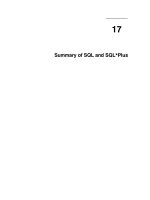Tài liệu Results of Lobectomy and Pneumonectomy in Pulmonary TB docx
Bạn đang xem bản rút gọn của tài liệu. Xem và tải ngay bản đầy đủ của tài liệu tại đây (202.55 KB, 6 trang )
Abbasi Dezfouli A, et al.
33
Tanaffos 2003; 2(7): 33-39
Tanaffos (2003) 2(7), 33-39
2003 NRITLD, National Research Institute of Tuberculosis and Lung Disease, Iran
Results of Lobectomy and Pneumonectomy in Pulmonary TB
Azizollah Abbasi Dezfouli, Abolghasem Daneshvar Kakhki, Roya Farzanegan, Mojtaba Javaherzadeh
Department of Thoracic Surgery, NRITLD, Shaheed Beheshti University of Medical Sciences and Health Services, TEHRAN-IRAN
ABSTRACT
Background: The results of lobectomy and pneumonectomy in treating various benign and malignant lesions of lung have been reported.
The complications and results of such procedures in the presence of pulmonary tuberculosis (TB) have been described in older texts.
However these reports have lessened due to the decrease in the number of patients seen over the last decades. Thus, it's not clear that to
what extent the advancements seen in surgical and anesthetic procedures were effective in lessening the complications of such procedures.
Materials and Methods: The study group consisted of all referral patients suffering from pulmonary TB or its complications that had
undergone lobectomy or pneumonectomy in Massih Daneshvari Hospital from October 1996 to September 2003 (7 years). All the necessary
information and data were collected from both medical records of the patients and special questionnaires that were designed by our staff in
1996 for this purpose. Statistical analysis was carried out descriptively by using frequency and percentage. Presence of TB in the patients
was confirmed by identifying the microorganism in the tissues detecting pathological changes in favour of TB and/or having past history of
pulmonary TB associated with its anatomical complications such as cavitation, bronchiectasis, and bronchial stenosis.
Results: A total number of 172 patients underwent surgical procedures either for diagnosis of TB or managing its complications. Lobectomy
was performed in 27 patients while 7 underwent pneumonectomy. The indications for these surgical procedures were: recurrent hemoptysis
(24 cases), massive hemoptysis (4 cases), multi drug resistant TB (4 cases), bronchiectasis and recurrent infection (2 cases), and right
bronchial stenosis (1 case). In two of the patients the indication for surgery was intra-bronchial carcinoid tumour. Lymph node biopsies
obtained during the surgery showed pathological changes of TB. The most important complications observed were severe bleeding occurring
after right pneumonectomy, empyema at the site of left superior lobectomy, and stenosis at the distal part of trachea in a patient who had
right bronchial stenosis and destruction of superior lobe for which sleeve lobectomy was performed. All the above-mentioned complications
were managed with appropriate treatment. The only exception was the patient having distal tracheal stenosis who needed repeated
dilatation.
There were five deaths in this group of patients: 3 in the lobectomy group (3 deaths out of total 27 lobectomies performed i.e. 11.1%) and 2
deaths in pneumonectomy group (2 deaths in total 7 pneumonectomies performed i.e. 28.5%). The causes of death were cardiac
complications (2 cases), respiratory failure (2 cases), and unknown cause (1 case). Four out of the five expired cases had undergone
emergency thoracotomy despite the fact that they were placed in the high risk group for operation. Surgery in other cases was successful
with the aims being reached. Also, out of 4 patients that had been treated for Multi-drug Resistant TB (MDR-TB), one became smear positive
showing the relapse of the disease.
Conclusion: Performing the surgical procedures of lobectomy and pneumonectomy in patients suffering from pulmonary TB is associated
with good results and complications that are "tolerable". However, mortality and morbidity rates' following pneumonectomy are higher than
usual cases. In these patients emergency thoracotomy results in high mortality. (Tanaffos 2003; 2(7): 33-39)
Key Words: Tuberculosis (TB), Surgical Management, Lobectomy, Pneumonectomy
Correspondence to: Abbasi Dezfouli A
Tel:+ 98-21- 2280161, Fax: +98-21-2285777
E-mail address: Abbasidezfouli@ nritld.ac.ir
ORIGINAL RESEARCH ARTICLE
34 Lobectomy and Pneumonectomy in Pulmonary TB
Tanaffos 2003; 2(7): 33-39
INTRODUCTION
The two surgical procedures of lobectomy and
pneumonectomy are carried out in vast number not
only in the treatment of bronchogenic carcinoma but
also in other benign and malignant diseases of lung.
Nowadays, these two procedures are seldom used
for the management of pulmonary TB or its
complications. Thus, the complications, mortality
and morbidity rates of such procedures remain
unknown.
The first successful pneumonectomy was carried
out by Evart Graham (1) in 1933 in a patient who
had lung carcinoma. The method used was "Mass
ligature" without any vascular or bronchial
dissection. Later on, Churchil and Belsey (2)
performed large number of lobectomies and
pneumonectomies for benign and malignant lesions
of the lung. They performed these procedures by
dissecting and ligating the vessels and bronchi of
each lobe separately.(3-4) At that time, anti-TB
mediations had not been discovered yet. Because
the surgeons were content with the outcomes of
pneumonectomy and lobectomy in diseases other
than TB, decision to use these surgical procedures
for treating TB and or its complications such as
infectious cavities, hemorrhages, and
bronchopleural fistulas was taken. Unfortunately,
carrying out such surgical procedures in pulmonary
TB patients was associated with high mortality and
morbidity rates. This resulted in a feeling of
hopelessness and despair in surgeons. An example
that can be given in this regard is an analytical
report dating back to 1940. In this report out of total
50 pulmonary TB patient that had undergone
pneumonectomy (19 cases) and lobectomy (31
cases), the mortality rates were 8(40%) and 6(20%)
respectively. In addition, in case of the living ones,
the results of the surgery were not satisfactory (5).
With the discovery of Streptomycin in 1945 as
the first anti-TB medication, many patients were
managed without undergoing surgery. Nevertheless,
with early emergence of resistance to streptomycin,
there was an inclination to surgical management of
TB once more. This time, surgery was conducted
using streptomycin and temporary sterilizing
sputum and tuberculous cavity. This resulted in
lower mortality and morbidity rates. Despite the
presence of fibrous adhesions and fibrosis (as a
result of TB) making surgery difficult, fewer
complications with lower mortality and morbidity
rates were observed; the complication being very
similar to that of pulmonary resections performed
for other non-TB diseases. Once again, with the
appearance of more effective anti-TB medications,
the surgical management of TB was nearly put
aside. With the temporary resolving of drug
resistant issue, surgical management of TB during
the sixties was totally forgotten. However, after the
eighties, re-appearance of resistant microorganisms,
presence of immunosuppressed patients, and
emergence of cases that were infected with atypical
microorganism resulted in reversion to surgical
management of TB (6-10).
Once again, surgery came to help by saving the
lives of MDR-TB patients. A study was conducted
by Pomerantz and coworkers (11) on the surgical
management of MDR-TB in the United States of
America. They reported satisfactory results in this
regard. However, the situation was different in the
developing countries. Tuberculosis was never
eradicated completely from these countries and at
all times, cases suffering either from active TB or its
complications such as lung destruction, active
cavities, resistant pleurisy and hemorrhages existed,
that needed surgical treatment. In these
circumstances surgeons offered valuable services to
patients. Some of the patients undergo lobectomy
while in some pneumonectomy is performed. In
these cases the complications of lobectomy and
pneumonectomy are rarely reported separately, with
the results being unknown to some extent. Even
reports that recount more complications and higher
mortality/morbidity rates have been published in
Abbasi Dezfouli A, et al. 35
Tanaffos 2003; 2(7): 33-39
this matter. Thus we decided to evaluate the results
of such surgical procedures in our patients.
MATERIALS AND METHODS
Our study group consisted of all those patients
that were suffering from pulmonary TB and/or its
complications and had undergone pneumonectomy
or lobectomy in Massih Daneshvari Hospital during
Oct. 1996 and Sep. 2003. The surgical procedures
and outcomes were evaluated by studying both the
medical records of the patients and the special TB
questionnaire which was prepared by our staff in
1996. Statistical analysis was performed
descriptively using frequency and percentage.
In patients having past history of TB the
presence of TB in the samples were confirmed by
detecting the microorganism in the tissues,
observing pathological changes and/or
complications of TB in lungs such as bronchiectasis
and bronchial stenosis (Table 1).
All surgical procedures were conducted by the
surgery team of our center under the leadership of
one of the three senior surgeons. Clinical follow-up
was carried out accurately. In addition to the routine
"follow-up" attendances in the surgery clinic,
patients or their families would be contacted by
telephone whenever needed. The follow-up period
ranged from 7-180 days. The physicians of the
infectious and/or pulmonary units would administer
the necessary anti-TB treatment to the patients
under study. The pathology department of the
hospital conducted the necessary bacteriological and
pathological investigations.
RESULTS
Out of total 172 patients that were candidates for
surgery either for diagnosis of TB or management
of its complications, 34 underwent either lobectomy
or pneumonectomy and were considered as our
"study group". In gender issue; 15 were female and
19 were male. The mean age of the patients was 45.
(range of 15-74 yrs). In total, 27 lobectomies and 7
pneumonectomies were performed. The indications
of surgery were recurrent hemoptysis (24 cases)
massive hemoptysis (4 cases), MDR-TB (4 cases),
bronchiectasis and recurrent infection (2 cases) and
main right bronchial stenosis (1 case). In some of
the patients, more than one indication existed. In
two of the patients, the indication of surgery was
intrabronchial carinoid tumour. After surgery,
lymph node biopsies showed pathological changes
that confirmed TB. The main complications that
were observed after the surgeries included: severe
hemorrhage after right pneumoectomy (1 case),
empyema at the site of left superior lobectomy
(1 case), and distal tracheal stenosis (in a patient
who had undergone sleeve lobectomy because of
right bronchial stenosis and superior lobe
destruction). However, all the complications were
managed with appropriate treatment. The only
exception was the patient who had distal tracheal
stenosis requiring recurrent dilatation at the site of
stenosis. Table 2 shows the complications and their
management.
A total of 5 patients expired, 3 from lobectomy
group (3 out of 27 patients, 11.1%) and 2 from the
pneumonectomy group (2 out of 7 patients-28.5%).
The causes of death were severe cardiac
complications (2 cases), respiratory failure (2 cases)
and unknown (1 case). In the rest of the patients the
therapeutic results were satisfactory. The clinical
symptoms were carefully controlled. Also, out of
four patients with MDR-TB that had undergone
surgery, one became smear positive 4 months after
surgery. However, with appropriate medical
treatment the above-mentioned case becomes smear
negative once again. Table 3 shows the details of
expired cases.
Table 1. Basis of diagnosing TB in the patients
Methods Number
Positive TB pathology 11
Detecting the microorganism in the samples 5
Positive TB pathology + detecting the microorganism in
the samples
8
Past history of TB + pulmonary complication of TB 10
36 Lobectomy and Pneumonectomy in Pulmonary TB
Tanaffos 2003; 2(7): 33-39
Table 2. Complications of surgery
Surgical indication Surgical procedure
Complication seen after
surgery
Management of complication
Abscess and cavity in left upper lobe Left upper lobectomy Empyema at the surgical site Drainage by chest tube
Right bronchial stenosis and distal
tracheal stenosis
Right upper sleeve lobectomy
Persistence of distal tracheal
stenosis
Repeated dilatation
MDR-TB Left upper lobectomy
Reappearance of positive smear
4 months after surgery
Continuation of medical treatment
Carcinoid tumour and concomitant
TB in hilar lymph nodes
Right Pneumonectomy
Hemorrhage and clot formation
at the site of surgery
Drainage by thoracoscopy
Table 3. The details of mortalities
Disease
Age (yr.)
Sex
Surgical procedure Probable cause of death and its explanation
Bronchiectasis and recurrent hemoptysis
in the presence of pulmonary TB
70 F Right upper lobectomy
She died during operation due to severe arrhythmia.
Despite her unstable cardiovascular condition and
being placed in the high risk group, surgery was
performed in order to control hemoptysis.
MDR-TB and recurrent hemoptysis 59 M Right upper lobectomy
The patient died on 8
th
post-op day due to cardiac
failure. The reason for cardiac failure was high
pulmonary arterial pressure in the presence of diffuse
pulmonary fibrosis.
Cavitation in the apices of both lungs
with recurrent hemoptysis
44 M
Left upper lobectomy,
removal of right cavernous
wall
Death occurred because of respiratory failure.
Respiratory capacities were not satisfactory before
operation.
MDR-TB and destruction of left lung 15 M Left pneumonectomy
Sudden death on the 4
th
post-op day due to unknown
reason.
Recurrent massive hemoptysis, MDR-
TB, bronchiectasis in the presence of
pulmonary TB
57 M Right pneumonectomy
The patient was kept on ventilator due to respiratory
failure and oedema; died after 12 days.
Abbasi Dezfouli A, et al.
37
Tanaffos 2003; 2(7): 33-39
DISCUSSION
Complications of lobectomy vary not only in the
hands of surgeons but also at centers in which they
are performed. For example in a report given by
Ginsberg et al. in 1983, the total mortality and
morbidity rate for surgical management of lung
carcinoma was 3.3% (12).
Recently carried out retrospective studies have
shown mortality and morbidity rates of 6-7% for
pneumonectomies, while that of lobectomies should
not exceed 2% (13). Surgical management of TB is
usually associated with higher mortality and
morbidity rates as well as complications.
Although our mortality and morbidity rates are
high, looking at the information listed in table 3
clarifies the issue. The first patient was a 70-year-old
female that had severe myocardial dysfunction. After
being examined by the cardiologist, she was placed
in the “very high risk group” of surgery. However,
life threatening recurrent hemoptysis and absence of
response to other therapies such as embolization of
bronchial arteries by angiography left us no choice
but surgery. The patient expired because of cardiac
complications that appeared during the operation. In
the second patient, the pulmonary arterial pressure
was high before the surgery. The third patient
suffered from complete destruction of both the apices
of lungs. His pulmonary capacities were also below
normal values before the start of the operation.
However, they became surgical candidates because
of life threatening recurrent hemoptysis. The fifth
patient had decreased pulmonary capacities. Surgery
was essential in this case since he had massive
hemoptysis. Despite the unstable and critical
condition of the above-mentioned patients, they had
to undergo surgery. Overall, emergency operations
for managing massive hemoptysis are associated with
high mortality and morbidity rates; especially if
pneumonectomy is performed for treating TB (14).
Although the mortality and morbidity rate reported
by Pomerantz and coworkers was 2.4%, more than
12% of the deaths were due to non-surgical causes.
As seen in our research, most of the patients died due
to non-surgical causes such as cardiac dysfunction
decreased respiratory capacities and life threatening
situation that made surgery essential. The only
exception was patient no.4, who had MDR-TB and
became candidate for surgery. In his case the risk of
surgery was not high. His condition was stable until
the fourth post-op day, when he died suddenly and
unexpectedly. In regard to the cause of death in this
patient, we assumed different reasons including
vasovagal shock and sudden cardiorespiratory arrest.
In spite of the five deaths that occurred, the
therapeutic results in the rest of the patients were
satisfactory. Most of the patients had critical
conditions and were operated under difficult surgical
circumstances. Fewer complications would have
been observed if they had been treated in appropriate
condition (15,16).
CONCLUSION
Performing lobectomy and pneumonectomy as a
therapeutic procedure in patients suffering from
pulmonary TB is associated with good results and
complications that are “tolerable”. However,
pneumonectomy carries higher mortality and
morbidity rates as compared to usual cases.
REFERENCES
1. Graham EA, Singer JJ. Successful removal of an entire lung
for carcinoma of the bronchus. JAMA 1933; 101: 1371. 75:
257-320.
2. Churchill ED, Belsey R. Segmental pneumonectomy in
bronchiectasis. Ann Surg 1939; 109: 481-92.
3. Churchill ED. The surgical treatment of carcinoma of the
lung. J Thorac Surg 1933; 2: 254-61.
4. Churchill ED, Klopstock R. Lobectomy for pulmonary
tuberculosis. Ann Surg 1943; 117: 641.
38 Lobectomy and Pneumonectomy in Pulmonary TB
Tanaffos 2003; 2(7): 33-39
5. Jones JC. Early experience with resection in pulmonary
tuberculosis in the surgical management of pulmonary
tuberculosis. In JD Steele (Ed); The Surgical management
of pulmonary tuberculosis. Springfield: Charles C Thomas,
1957.
6. Picciocchi A, Granone P, Margaritora S, Cesario A, Galetta
D. Surgical management of pulmonary tuberculosis. Rays
1998; 23(1): 193-202.
7. Shiraishi Y, Fukushima K, Komatsu H, Kurashima A. Early
pulmonary resection for localized mycobacterium avium
complex disease. Ann Thorac Surg 1998; 66(1): 183-6.
8. Lardinois D, Furrer M, Mouton W, Gugger M, Ris HB.
Surgical aspects of mycobacterioses. Evolution during the
last 20 years. Schweiz Med Wochenschr 1997; 127(47):
1961-8.
9. Wu MH, Lin MY, Tseng YL, Lai WW. Results of surgical
treatment of 107 patients with complications of pulmonary
tuberculosis. Respirology 1996; 1(4): 283-9.
10. Kir A, Tahaoglu K, Okur E, Hatipoglu T. Role of surgery in
multi-drug- resistant tuberculosis: results of 27 cases. Eur J
Cardiothorac Surg 1997; 12(4): 531-4.
11. Pomerantz M, Madsen L, Goble M, Iseman M. Surgical
management of resistant mycobacterial tuberculosis and
other mycobacterial pulmonary infections. Ann Thorac
Surg 1991; 52(5): 1108-11; discussion 1112.
12. Ginsberg RJ, Hill LD, Eagan RT, Thomas P, Mountain CF,
Deslauriers J, et al. Modern thirty-day operative mortality
for surgical resections in lung cancer. J Thorac Cardiovasc
surg 1983; 86(5): 654-8.
13. Ginsberg RJ, Martini N. Non-Small-Cell lung cancer.
Surgical management. In: Pearson FG, Cooper JD,
Deslauriers J, Ginsberg RJ, Hiebert CA, Alexander
Patterson GA, Urschel HC. Thoracic Surgery. Churchill
Livingstone; 2002: 32, 853.
14. Stevens MS, de Villiers SJ, Stanton JJ, Steyn FJ.
Pneumonectomy for severe inflammatory lung disease.
Results in 64 consecutive cases. Eur J Cardiothorac Surg
1988; 2(2): 82-6.
15. Treasure RL, Seaworth BJ. Current role of surgery in
Mycobacterium tuberculosis. Ann Thorac Surg 1995;
59(6): 1405-7; discussion 1408-9.
16. Reed CE, Parker EF, Crawford FA Jr. Surgical resection for
complications of pulmonary tuberculosis. Ann Thorac Surg
1989; 48(2): 165-7.









